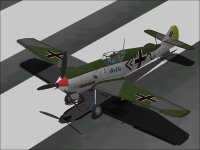Hello Rince33,
How accurately does Cfs1 portray real world physics? If it's not that accurate then whatever flight data is used by the model, authentic or not, will be inacurate. Just wondering about this.
From what I have heard and from my own limited experience, the simulator in CFS1 which isn't greatly different from later sims does a pretty fair job as long as the attitude of the aircraft is "Normal": More or less with the nose in the direction of travel. As soon as the aircraft starts tumbling, going sideways, backwards and presenting some other undefined profile to the "Airflow", the calculation of movement becomes questionable.
ALL desktop class flight simulators have this problem.
If you want to do better than this, you need to get the software that engineers and the military uses and that stuff from what I have heard is generally about the cost of a new car.
Within the capabilities of the desktop simulators, the accuracy of the flight model has a pretty great effect on how "correctly" the virtual aeroplane will mimic the handling and performance of the real aircraft. Often the data that is needed isn't available so we as designers need to take a best guess. There are also many ways to get the same effect. This is why I commented that Aleatorylamp and I didn't agree on Superchargers or Propeller Tables. I believe I am correct and he probably believes he is correct.
As for "Data" on handling, the P-39 Airacobra that we each designed is a pretty good example. We both have heard that the aircraft had a CoG that was too far aft when unloaded and that it was unstable. We each took a different approach.
I went through a lot of reports and believe my flight model mimics the behaviour pretty well with characteristics I expect to find.
He probably did something similar. The big question here is what does "unstable" mean to each of us? None of us has actually flown an Airacobra.
The differences in interpretations means the results we each got were quite different.
Cfs1 flight model does seem to fly differently to most older sims, there seems to be a bit more lateral movement in turns when trying to get on the tail of enemy ai which makes the process more difficult and more authentic I think. This is more pronounced in the 1% version where the rudder effects seem weaker.
The AIR file in CFS1 has a lot more ability to control stability and moments in various directions than prior flight models such as FS98. Whether it is done correctly for a particular aircraft is another story entirely. I have heard that various stock aircraft were intended to be flown with different simulator settings. The "Easy" setting makes aircraft much more stable and I believe the Hurricane was actually intended for that. When stability is generally reduced in the "Hard" simulator setting, perhaps the flight model (AIR File) isn't a good match with what the simulator is doing.
Just about all the issues you are describing can be pretty seriously altered by editing the AIR file in the correct places.
As for the 1% business, all their system really addresses is straight line performance. They do not make any claims to addressing handling and I believe that handling affects the perception of agility and maneuverability much more so than straight line performance. (How many players complain that the Me 109G is 100 MPH too fast???)
I can give you two aircraft that have the same maximum speeds, climb rates, stall speeds, ceiling, etc. with one that you can aim instinctively, maneuver in tight places, and is a killer in a close in dogfight and another that can't do any of those just by tuning the handling a bit.
This is actually what I spent a couple hours doing for the La-5FN two days ago. The original version was much too responsive and agile and didn't have the gotchas that the real one did. I am still not done and even when I am, the result will be subject to debate: When the report says the ailerons get stiff at about 370 MPH, HOW much roll rate is lost???? I don't really know so I have to guess a bit.
- Ivan.




